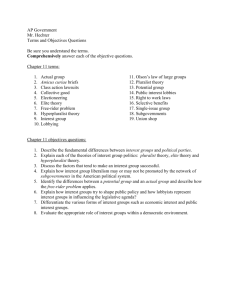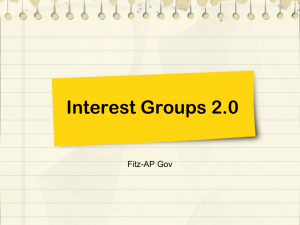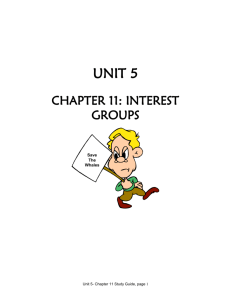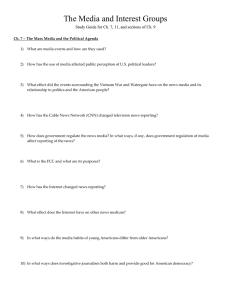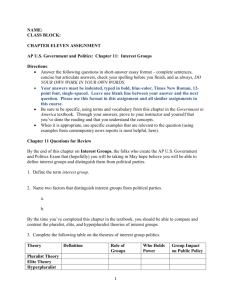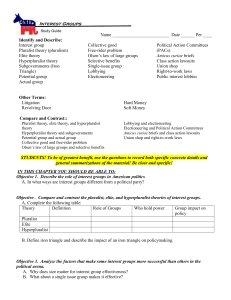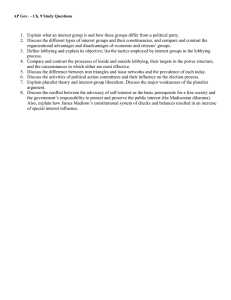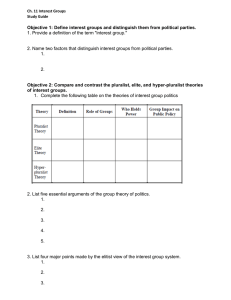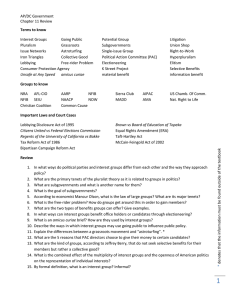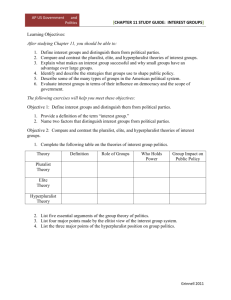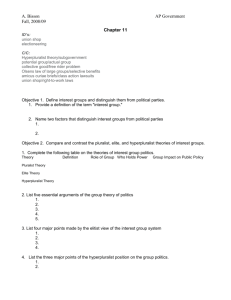Chapter 11: Interest Groups Pre-Quiz
advertisement
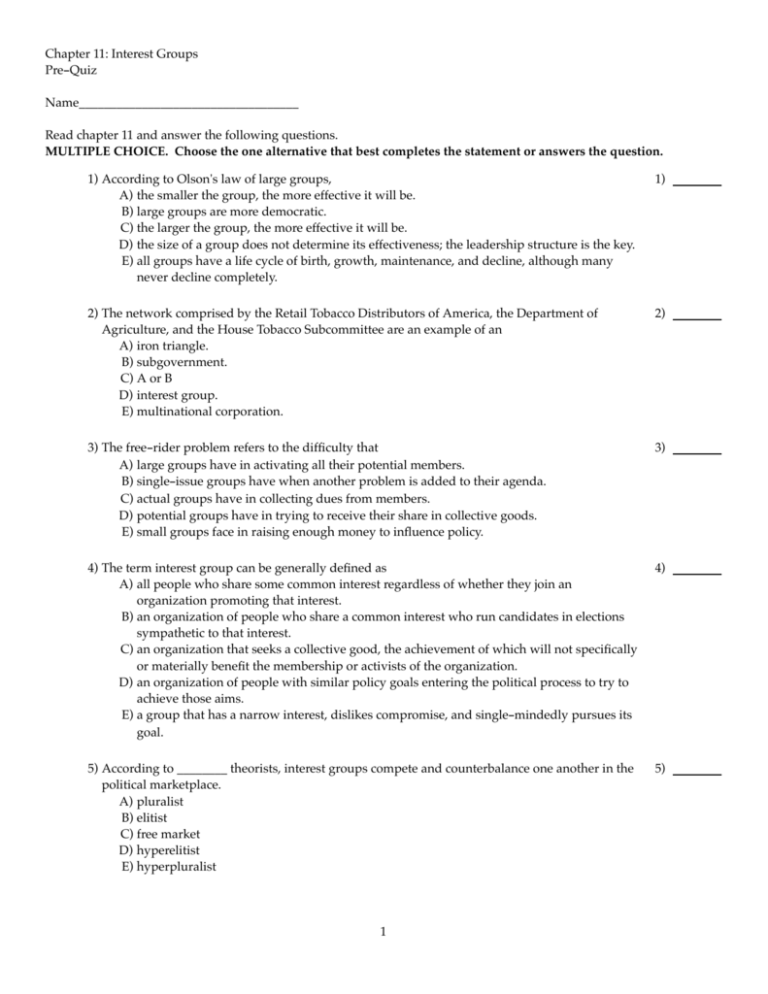
Chapter 11: Interest Groups Pre-Quiz Name___________________________________ Read chapter 11 and answer the following questions. MULTIPLE CHOICE. Choose the one alternative that best completes the statement or answers the question. 1) According to Olson's law of large groups, A) the smaller the group, the more effective it will be. B) large groups are more democratic. C) the larger the group, the more effective it will be. D) the size of a group does not determine its effectiveness; the leadership structure is the key. E) all groups have a life cycle of birth, growth, maintenance, and decline, although many never decline completely. 1) 2) The network comprised by the Retail Tobacco Distributors of America, the Department of Agriculture, and the House Tobacco Subcommittee are an example of an A) iron triangle. B) subgovernment. C) A or B D) interest group. E) multinational corporation. 2) 3) The free-rider problem refers to the difficulty that A) large groups have in activating all their potential members. B) single-issue groups have when another problem is added to their agenda. C) actual groups have in collecting dues from members. D) potential groups have in trying to receive their share in collective goods. E) small groups face in raising enough money to influence policy. 3) 4) The term interest group can be generally defined as A) all people who share some common interest regardless of whether they join an organization promoting that interest. B) an organization of people who share a common interest who run candidates in elections sympathetic to that interest. C) an organization that seeks a collective good, the achievement of which will not specifically or materially benefit the membership or activists of the organization. D) an organization of people with similar policy goals entering the political process to try to achieve those aims. E) a group that has a narrow interest, dislikes compromise, and single-mindedly pursues its goal. 4) 5) According to ________ theorists, interest groups compete and counterbalance one another in the political marketplace. A) pluralist B) elitist C) free market D) hyperelitist E) hyperpluralist 5) 1 6) Pluralism is a(n) ________ theory of politics. A) elite B) rational C) individual D) group E) liberal 6) 7) A pluralistic interpretation of interest group politics would maintain that A) the degree of organization of a group has no effect on its ability to influence policy. B) all legitimate groups can affect public policy by means of one political resource or another. C) all groups are subject to corrupt practices and tactics involving violence. D) the overemphasis on groups in America has submerged the value of the individual and led to government policies that suppress individual interests. E) when groups compete the public interest is not served. 7) 8) The idea that just a few groups have all the power is associated with A) syndicalism. B) pluralist theory. C) hyperpluralist theory. D) elite theory. E) democratic theory. 8) 9) Elitist theorists argue that A) the larger the group, the further it will fall short of providing an optimal amount of a collective good. B) groups weak in one resource can use another, and all legitimate groups are able to affect public policy by one means or another. C) the government has treated all interest group demands as legitimate, and unwisely chosen to advance them all. D) the fact that there are numerous groups proves nothing, because most groups are extremely unequal in power. E) governments should be controlled by a select group of well-educated, cultured, wealthy persons who understand the laws of economics and can run the most efficient government. 9) 10) Subgovernments are A) networks of groups within the American political system that exercise power over specific policy areas. B) also known as iron triangles. C) composed of key interest group leaders, government agencies in charge of administrative policy, and congressional committees all interested in particular policy areas. D) Both A and B E) All of the above 2 10) 11) The criticism that government refuses to make tough choices between X or Y, instead pretending there is no need to choose and trying to favor both is most often made by ________ theorists. A) elitist B) hyperpluralist C) hyperelitist D) rational choice E) pluralist 11) 12) All subgovernments have the same goal of A) protecting the public interest. B) joining the main government. C) attacking the government head-on. D) electing the most qualified people to office. E) protecting their self-interest. 12) 13) Which of the following is NOT one of the major elements of the subgovernment system at the national level? A) Federal court B) Federal agency C) Bureaucrats D) Congressional committee E) Interest group 13) 14) Which of the following statements is TRUE? A) Larger interest groups are more likely to achieve their goals than are smaller interest groups. B) Smaller interest groups are more likely to achieve their goals than are larger interest groups. C) Greater intensity and more financial resources work to an interest group's advantage. D) Both A and C E) Both B and C 14) 15) The primary way that groups overcome Olson's law is through A) reducing membership fees. B) decentralizing. C) centralizing. D) mandatory membership. E) selective benefits. 15) 16) An advantage of single-issue groups is their A) intensity. B) pool of actual members. C) pool of potential members. D) financial resources. E) diversity. 16) 3 17) "A communication, by someone other than a citizen acting on his own behalf, directed to a governmental decision maker with the hope of influencing his decision" is called A) free-riding. B) litigating. C) electioneering. D) lobbying. E) collecting benefits. 17) 18) A "communication by someone other than a citizen acting on his or her own behalf, directed to a governmental decision maker with the hope of influencing his or her decision" is a definition of A) electioneering. B) campaigning. C) lobbying. D) a policy output. E) litigation. 18) 19) Lobbying A) works best on people already committed to the lobbyist's policy position. B) is frequently effective at changing a politician's policy position on issues. C) is primarily directed toward activating and reinforcing supporters. D) depends on lobbyists ability to deploy information strategically. E) A, C, and D 19) 20) An amicus curiae brief is A) an oral or written appeal of a court decision made by an interest group that is party to the particular case. B) one that enables a group of similarly situated plaintiffs to combine similar grievances into a single suit to pursue a remedy for past wrongs. C) a written argument submitted to the courts in support of one side of a case. D) an oral or written appeal of a court decision made by an interest group not party to a particular case. E) the written statement of a court's decision in a case explaining the reasons for the decision. 20) 4 Answer Key Testname: AP GOV CH 11 PRE QUIZ 1) A 2) C 3) A 4) D 5) A 6) D 7) B 8) D 9) D 10) E 11) B 12) E 13) A 14) E 15) E 16) A 17) D 18) C 19) E 20) C 5
